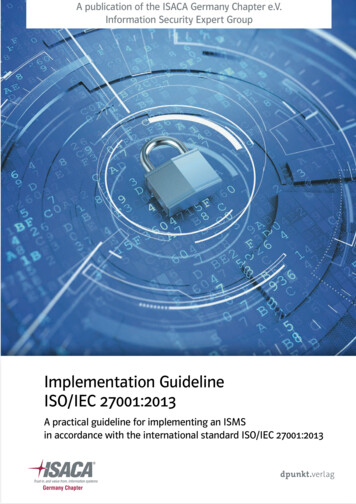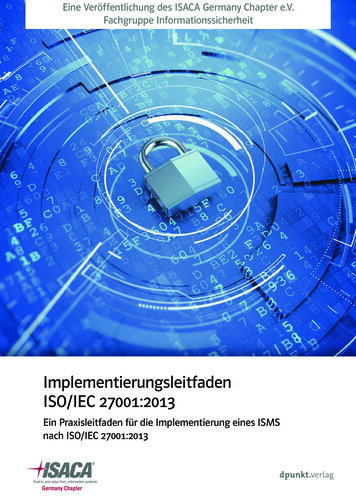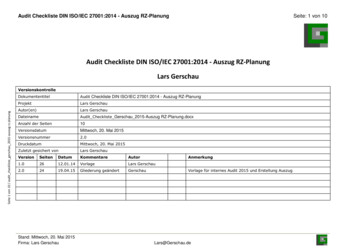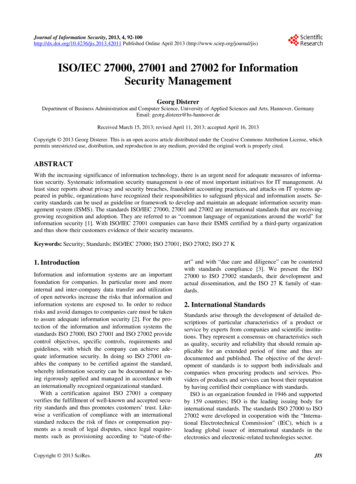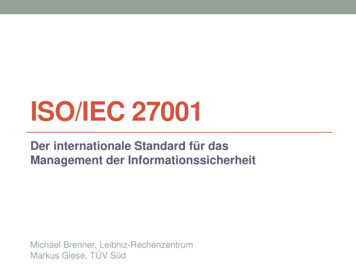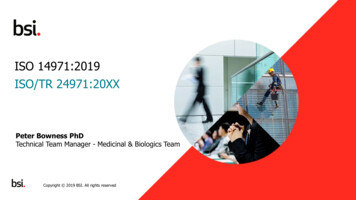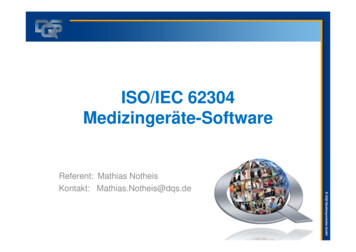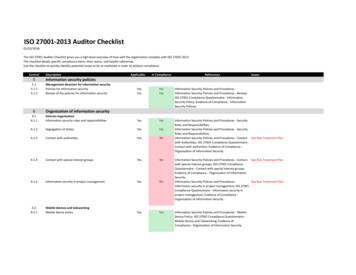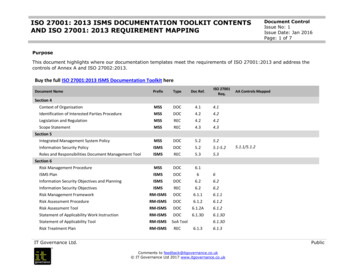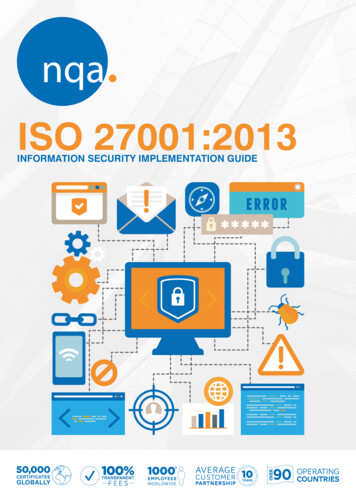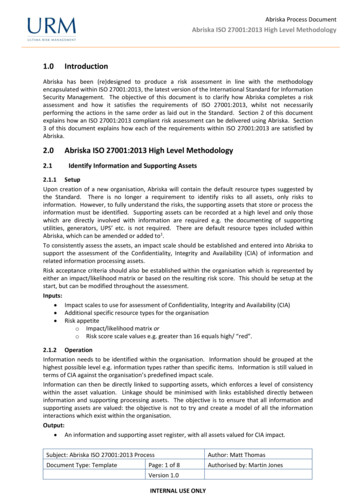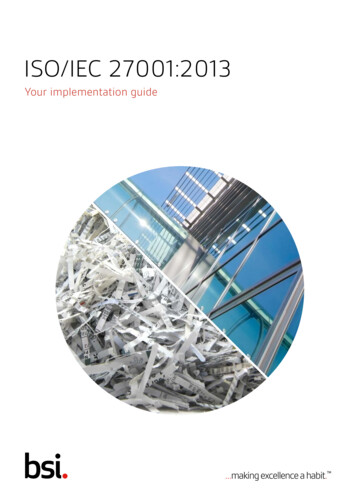
Transcription
ISO/IEC 27001:2013Your implementation guide
What is ISO/IEC 27001?Successful businesses understand the value of timely,accurate information, good communications andconfidentiality. Information security is as much aboutexploiting the opportunities of our interconnectedworld as it is about risk management.That’s why organizations need to build resiliencearound their information security management.Internationally recognized ISO/IEC 27001 is anexcellent framework which helps organizationsmanage and protect their information assetsso that they remain safe and secure.At BSI, we have the experience, the experts and thesupport services to help make sure you get the mostfrom ISO/IEC 27001, by making you more resilientand responsive to threats to your information.This guide shows you how to implementISO/IEC 27001 in your organization to buildresilience for the long term and safeguard yourreputation. We also showcase our additionalsupport services, which help you not only achievecertification, but continue to reduce risk and protectyour business.“ISO/IEC 27001 demonstratesto clients that we have securedata and robust systems.”Hugo Holland Bosworth,Group Operations Director, Alternative Networks PlcContents B enefits ISO/IEC 27001: 2013 clauseby clause Top tips from our clients Your ISO/IEC 27001 journey BSI Training Academy BSI Business ImprovementSoftware2
How ISO/IEC 27001 works and what itdelivers for you and your companyThe ability to manage information safely and securely has never been more important. ISO/IEC 27001 notonly helps protect your business, but it also sends a clear signal to customers, suppliers, and the marketplace that your organization has the ability to handle information securely.ISO/IEC 27001 is a robust framework that helps you protect information such as financial data, intellectualproperty or sensitive customer information. It helps you identify risks and puts in place security measuresthat are right for your business, so that you can manage or reduce risks to your information. It helps you tocontinually review and refine the way you do this, not only for today, but also for the future. That’s howISO/IEC 27001 protects your business, your reputation and adds value.Benefits of ISO/IEC 27001:2013*75%80%71%reducesbusiness riskinspires trust inour businesshelps protectour business55%53%50%helps us complywith regulationsincreases ourcompetitiveedgereduces thelikelihood ofmistakes“It helped the team understand the threats and vulnerabilities that exist intoday’s environment and proactively control them. It has led to a greaterawareness, vigilance and enthusiasm for information security.”Mr. Tareq Al-Sahaf, General Manager. Gulf Insurance Group K.S.C (GIG)*Source: BSI Benefits survey - BSI clients were asked which benefits they obtained from ISO/IEC 27001:20133
How ISO/IEC 27001 worksThe latest version of ISO/IEC 27001 was published in 2013 to help maintain its relevance to the challengesof modern day business and ensure it is aligned with the principles of risk management contained in ISO31000. It’s based on the high level structure (Annex SL), which is a common framework for all revisedand future ISO management system standards, including ISO 9001:2015 and ISO 14001:2015.Annex SL helps keep consistency, align different management system standards, offermatching sub-clausesagainst the top level structure and apply a common language. It compels organizations to incorporate theirInformation Security Management System (ISMS) into core business processes, make efficiencies and getmore involvement from senior management.Some of the core concepts of ISO/IEC 27001:2013 are:4ConceptCommentContext of theorganizationConsider the combination of internal and external factors and conditions that canaffect the organization’s information.Issues, risks andopportunitiesIssues can be internal or external, positive or negative and include conditions thataffect the confidentiality, integrity and availability of an organization’s information.Risks are defined as the “effect of uncertainty on an expected result”.Interested partiesA person or entity that can affect, be affected by, or perceive themselves tobe affected by a decision or activity. Examples include suppliers, customers orcompetitors.LeadershipRequirements specific to top management who are defined as a person or group ofpeople who directs and controls an organization at the highest level.Risk associated withthreatsand opportunitiesRefined planning process replaces preventive action and is defined as the ‘effect ofuncertainty on an expected result’.CommunicationThe standard contains explicit and detailed requirements for both internal andexternal communications.Documented informationThe meaningful data or information you control or maintain to support your ISMS.Performance evaluationThe measurement of the ISMS and risk treatment plan effectiveness.Risk ownerThe person or entity that has been given the authority to manage a particular risk andis accountable for doing so.Risk treatment planA risk modification plan which involves selecting and implementing one or moretreatment options against a risk.ControlsAny administrative, managerial, technical, or legal method that is used to modify ormanage an information security risk. They can include things like practices, processes,policies, procedures, programs, tools, techniques, technologies, devices, andorganizational structures. They are determined during the process of risk treatment.Continual improvementMethodologies other than Plan-Do-Check-Act (PDCA) may be used.
Key requirements ofISO/IEC 27001:2013Clause 1: ScopeThe first clause details the scope of the standard.Clause 2: Normative referencesAll the normative references are contained in ISO/IEC 27000, Information technology – Securitytechniques – Information security managementsystems – Overview and vocabulary, which isreferenced and provides valuable guidance.topics such as any market assurance and governancegoals.You will be required to decide on the scope of yourISMS, which needs to link with the strategic directionof your organization, core objectives and therequirements of interested parties.Finally, you’ll need to show how you establish,implement, maintain and continually improve theISMS in relation to the standard.Clause 3: Terms and definitionsClause 5: LeadershipPlease refer to the terms and definitions containedin ISO/IEC 27000. This is an important document toread.This clause is all about the role of “top management,”which is the group of people who direct and controlyour organization at the highest level. They will needto demonstrate leadership and commitment byleading from the top.Clause 4: Context of the organizationThis is the clause that establishes the context of theorganization and the effects on the ISMS. Much ofthe rest of the standard relates to this clause.The starting point is to identify all external andinternal issues relevant to your organization andyour information or information that is entrustedto you by 3rd parties. Then you need to establish all“interested parties” and stakeholders as well as howthey are relevant to the information. You will needto identify requirements for interested parties whichcould include legal, regulatory and/or contractualobligations. You’ll also need to consider importantTop management need to establish the ISMS andinformation security policy, ensuring it is compatiblewith the strategic direction of the organization.They also need to make sure that these are madeavailable, communicated, maintained and understoodby all parties.Top management must ensure that the ISMSis continually improved and that direction andsupport are given. They can assign ISMS relevantresponsibilities and authorities, but ultimately theyremain accountable for it.5
Clause 6: PlanningClause 7: SupportThis clause outlines how and organization plansactions to address risks and opportunities toinformation.This section of ISO/IEC 27001 is all about gettingthe right resources, the right people and the rightinfrastructure in place to establish, implement,maintain and continually improve the ISMS.It focuses on how an organization deals withinformation security risk and needs to beproportionate to the potential impact theyhave. ISO 31000, the international standard forrisk management, contains valuable guidance.Organizations are also required to produce a“Statement of Applicability” (SoA). The SoA providesa summary of the decisions an organization hastaken regarding risk treatment, the control objectivesand controls you have included, and those you haveexcluded and why you have decided to include andexclude the controls in the SOA.Another key area of this clause is the need toestablish information security objectives and thestandard defines the properties that informationsecurity objectives must have.It deals with requirements for competence,awareness and communications to support the ISMSand it could include making training and personnelavailable, for example.This clause also requires all personnel workingunder an organization’s control to be aware of theinformation security policy, how they contributeto its effectiveness and the implications of notconforming.The organization also needs to ensure thatinternal and external communications relevant toinformation security and the ISMS are appropriatelycommunicated. This includes identifying what needsto be communicated to whom, when and how this isdelivered.It’s in this clause that the term “documentedinformation” is referenced. Organizations need todetermine the level of documented information that’snecessary to control the ISMS.There is also an emphasis on controlling accessto documented information, which reflects theimportance of information security.6
Clause 8: OperationThis clause is all about the execution of the plans andprocesses that are the subject of previous clauses.It deals with the execution of the actions determinedand the achievement of the information securityobjectives. In recognition of the increased use ofoutsourced functions in today’s business world, theseprocesses also need to be identified and controlled.Any changes, whether planned or unintended need tobe considered here and the consequences of these onthe ISMS.It also deals with the performance of informationsecurity risk assessments at planned intervals, and theneed for documented information to be retained torecord the results of these.Finally, there is a section that deals with theimplementation of the risk treatment plan, and again,the need for the results of these to be retained indocumented information.Clause 9: Performance evaluationThis clause is all about monitoring, measuring,analyzing and evaluating your ISMS to ensure thatit is effective and remains so. This clause helpsorganizations to continually assess how they areperforming in relation to the objectives of thestandard to continually improve.You will need to consider what information you needto evaluate the information security effectiveness, themethods employed and when it should be analyzedand reported.Internal audits will need to be carried out as wellas management reviews. Both of these must beperformed at planned intervals and the findings willneed to be retained as documented information.It should be noted that management reviews are alsoan opportunity to identify areas for improvement.Clause 10: ImprovementThis part of the standard is concerned with correctiveaction requirements. You will need to show how youreact to nonconformities, take action, correct themand deal with the consequences. You’ll also needto show whether any similar nonconformities existor could potentially occur and show how you willeliminate the causes of them so they do not occurelsewhere.There is also a requirement to show continualimprovement of the ISMS, including demonstratingthe suitability and adequacy of it and how effective itis. However you do this is up to you.ISO/IEC 27001 also includes Annex A which outlines114 controls to help protect information in a varietyof areas across the organization. ISO/IEC 27002 alsoprovides best practice guidance and acts as a valuablereference for choosing as well as excluding whichcontrols are best suited for your organization.7
Top tips on making ISO/IEC 27001effective for youEvery year we help tens of thousands of clients. Here are their top tips. Top management commitment is keyto making implementation ofISO/IEC 27001 a success. They need to beactively involved and approve theresources required.Think about how different departmentswork together to avoid silos. Make sure theorganization works as a team for the benefit ofcustomers and the organization.“The earlier that organizations talk to seniormanagers, the better it will go for them sohave those discussions early”.John Scott, Overbury, leading UK fit-out andrefurbishment business“The key to implementing the standard layin getting staff to think about informationsecurity as an integral part of the dailybusiness and not as an additional burden”.Mr. Thamer, Ibrahim Ali Arab, Assistant GeneralManager I.T.Review systems, policies, procedures andprocesses you have in place – you may alreadydo much of what’s in the standard, and make itwork for your business. You shouldn’t be doingsomething just for the sake of the standard –it needs to add value.“Don’t try and change your business to fit thestandard. Think about how you do things andhow that standard reflects on how you do it,rather than the other way around”.Speak to your customers and suppliers. Theymay be able to suggest improvements and givefeedback on your service.“This certification allows us to go one stepfurther by offering our customers the peace ofmind that we have the best controls in placeto identify and reduce any risks to confidentialinformation”.Paul Brazier, Commercial Director, OverburyJitesh Bavisi, Director of Compliance, Exponential-eBavisiTrain your staff to carry our internal auditsof the sys
Benefits of ISO/IEC 27001:2013* How ISO/IEC 27001 works and what it delivers for you and your company The ability to manage information safely and securely has never been more important. ISO/IEC 27001 not only helps protect your business, but it also sends a clear signal to customers, suppliers, and the market place that your organization has the ability to handle information securely. ISO/IEC 27001 File Size: 1MBPage Count: 12

